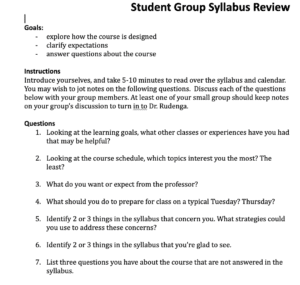Building Better Bookends: The First Day of Class
By Kristi Rudenga
What does a good first day of class look like?
On the first day of class, aim to facilitate students’ connections – to yourself as the instructor, to each other, and to the content of the course. Also aim to establish expectations by assessing students’ baseline knowledge, engaging students in a discussion of the syllabus, and teaching something in the format that you’ll use through the semester.
Why focus on the first day?
Your first day of class is crucial for student motivation, classroom community, and setting the tone for your semester. For these reasons, clearly establishing your own goals for the first day and designing a class session to meet those goals is an excellent use of your course preparation time.
How to design a successful first day of class:
Facilitate students’ connection with you:
Before and during the first day of class, make an effort to learn student names. As they arrive in the room, greeting them and chatting goes a long way toward establishing a comfortable classroom environment. Once class begins, take a moment to introduce yourself and express enthusiasm for the class and for your students. This may feel cheesy, but it truly helps student motivation if they perceive that you are happy to be there teaching them.
Consider collecting some information about your students using a paper questionnaire or a google form. This is a good chance to learn more about your students, their motivations for taking your course, and their backgrounds. A few questions to be sure to include are preferred name, pronouns, and something open-ended along the lines of “What else would you like me to know about you or your circumstances this semester?” This will give students the opportunity – though not the obligation – to disclose whether they have particular concerns or complications that might be valuable for you to be aware of.
Facilitate students’ connection with each other:
To get started establishing a positive classroom community, ensure that every student talks to at least one other student (ideally more!) on the first day of class. Facilitate the exchange of contact information – for example, encourage students to exchange email information with the person sitting next to them – to help them feel connected to others in the room.
Facilitate students’ connection with course content:
Use an activity on day one to draw students in to the content of your course.
Sample student activity: “Write the Book”
Lyons et al (2003) suggest giving students the following tasks, to surface their preconceptions about your field and your course and give them a chance to begin drawing connections among subtopics:
- List everything you can think of that might be in a book entitled [course title]
- With a partner, share your ideas, categorize them, and give each category a name
- With another partner group, combine ideas and arrange into a table of contents
- Write it on chart paper or a white board, share, and discuss as a class
Sample student activity: Intriguing question
I use this activity on day one to start students thinking about how scientific questions are asked and answered, how we seek and use sources, and the importance of clarity in questions and nuance in answers.
Prompt: Your roommate, a history major, hears that you are taking “Food and the Brain” this semester. “Awesome!”, she says, “I’ve heard that we should all stop consuming high fructose corn syrup. Is that true?”
In 15 minutes, find an answer and an explanation for your roommate. Use the internet and work with others in the class.
Establish expectations:
Many of us have experienced classes where the instructor handed out a syllabus on day one, halfheartedly asked if there were any questions, and then dismissed the class. While that’s certainly not a pedagogically sound approach, you likely still want to help students become familiar with class expectations and the syllabus right away (although certainly a case can be made for reserving this for day two). Be sure to incorporate the types of classroom activities or formats you intend to use throughout the semester – if clicker questions or small group discussions will be part of most class sessions, be sure that they are also a part of the first class session! Be clear with your students about what your learning goals are for them, why those goals matter, and why you use particular formats, activities, or resources in pursuit of those goals. Finally, find ways to engage students with the syllabus or other course logistics in an active way.
Sample activity: Group Syllabus Review
Huston’s (2011) group syllabus review activity revolutionized my first day of class. I’ve included the instructions and questions that I use, and strongly encourage you to adapt the activity and the questions to meet your own needs, or to find another way to discuss class expectations in a student-active way.

Assess students’ baseline knowledge:
While you may wish to get a more concrete sense of what knowledge students are coming in with, you don’t want them to leave the first day of class feeling like they’ve already failed a quiz.
Sample activity: Knowledge probe.
Huston (2011) suggests an anonymous Knowledge Probe, where students self-report their level of familiarity with different terms and concepts. This may look like rating familiarity with a list of terms, or with images, as in the following:

Teach something
Students should leave the first day of class having learned or practiced something relevant to your course. While you should devote much of the class time to the above goals and strategies, do reserve time to get into course content. Aim to teach something grounded in a real world example that demonstrates the relevance of the course to students’ daily lives or the larger world. You may aim to teach a small something that’s quickly understandable, in order to foster a sense of competence among students, or to teach something challenging, that may blow student minds a bit, paired with the assurance that by the end of the course, they’ll be able to understand/solve/answer/consider this problem in entirely new ways. Either way, aim to send students on their way knowing more than they did before class, and ready to learn more throughout the course.